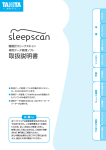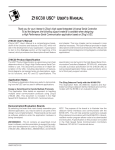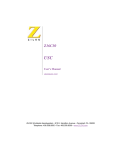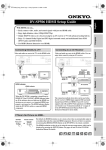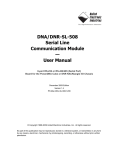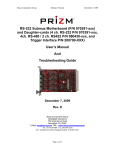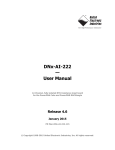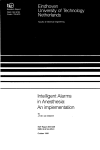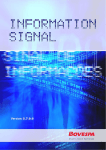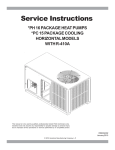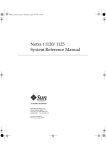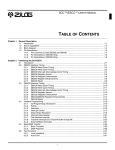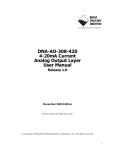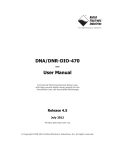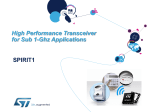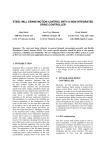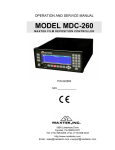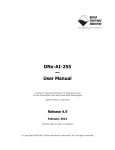Download DNA-SL-504 Product Manual - United Electronic Industries
Transcript
DNx-SL-504 — User Manual 4-Channel RS-232 or RS-422/423/485 (serial port) layer for the PowerDNA Cube and PowerDNR RACKtangle with support for Synchronous Serial Data Communcation protocols (SDLC, HDLC, async, bisync protocols) Release 4.5 November 2012 PN Man-DNx-SL-504-1112 © Copyright 1998-2012 United Electronic Industries, Inc. All rights reserved. No part of this publication may be reproduced, stored in a retrieval system, or transmitted, in any form by any means, electronic, mechanical, by photocopying, recording, or otherwise without prior written permission. Information furnished in this manual is believed to be accurate and reliable. However, no responsibility is assumed for its use, or for any infringement of patents or other rights of third parties that may result from its use. All product names listed are trademarks or trade names of their respective companies. See the UEI website for complete terms and conditions of sale: http://www.ueidaq.com/cms/terms-and-conditions/ Contacting United Electronic Industries Mailing Address: 27 Renmar Avenue Walpole, MA 02081 U.S.A. For a list of our distributors and partners in the US and around the world, please see http://www.ueidaq.com/partners/ Support: Telephone: Fax: (508) 921-4600 (508) 668-2350 Also see the FAQs and online “Live Help” feature on our web site. Internet Support: Support: Web-Site: FTP Site: [email protected] www.ueidaq.com ftp://ftp.ueidaq.com Product Disclaimer: WARNING! DO NOT USE PRODUCTS SOLD BY UNITED ELECTRONIC INDUSTRIES, INC. AS CRITICAL COMPONENTS IN LIFE SUPPORT DEVICES OR SYSTEMS. Products sold by United Electronic Industries, Inc. are not authorized for use as critical components in life support devices or systems. A critical component is any component of a life support device or system whose failure to perform can be reasonably expected to cause the failure of the life support device or system, or to affect its safety or effectiveness. Any attempt to purchase any United Electronic Industries, Inc. product for that purpose is null and void and United Electronic Industries Inc. accepts no liability whatsoever in contract, tort, or otherwise whether or not resulting from our or our employees' negligence or failure to detect an improper purchase. Specifications in this document are subject to change without notice. Check with UEI for current status. DNA/DNR-SL-504 Synchronous Serial Line Communication Module Contents Table of Contents Chapter 1 Introduction .................................................... 1 1.1 Organization of Manual. . . . . . . . . . . . . . . . . . . . . . . . . . . . . . . . . . . . . . . . . . . . . . . . 1 1.2 The SL-504 Interface Board . . . . . . . . . . . . . . . . . . . . . . . . . . . . . . . . . . . . . . . . . . . . 3 1.3 Features . . . . . . . . . . . . . . . . . . . . . . . . . . . . . . . . . . . . . . . . . . . . . . . . . . . . . . . . . . . 4 1.4 Indicators . . . . . . . . . . . . . . . . . . . . . . . . . . . . . . . . . . . . . . . . . . . . . . . . . . . . . . . . . . 4 1.5 Specification . . . . . . . . . . . . . . . . . . . . . . . . . . . . . . . . . . . . . . . . . . . . . . . . . . . . . . . . 5 1.6 What is Serial Communication? . . . . . . . . . . . . . . . . . . . . . . . . . . . . . . . . . . . . . . . . . 6 1.7 OSI Layer 1 and Layer 2 Coordination . . . . . . . . . . . . . . . . . . . . . . . . . . . . . . . . . . . . 7 1.8 What is Synchronous Serial Communica-tion?. . . . . . . . . . . . . . . . . . . . . . . . . . . . . . 8 1.9 Architecture . . . . . . . . . . . . . . . . . . . . . . . . . . . . . . . . . . . . . . . . . . . . . . . . . . . . . . . 12 1.10 Module Capabilities. . . . . . . . . . . . . . . . . . . . . . . . . . . . . . . . . . . . . . . . . . . . . . . . . . 13 1.11 Wiring & Connectors . . . . . . . . . . . . . . . . . . . . . . . . . . . . . . . . . . . . . . . . . . . . . . . . . 14 1.12 Jumper Settings for Board Position . . . . . . . . . . . . . . . . . . . . . . . . . . . . . . . . . . . . . 15 Chapter 2 Programming with the High Level API . . . . . . . . . . . . . . . . . . . . . . . . . . . . . . 16 2.1 Creating a Session . . . . . . . . . . . . . . . . . . . . . . . . . . . . . . . . . . . . . . . . . . . . . . . . . . 16 2.2 2.2.1 2.2.2 Configuring the Resource String. . . . . . . . . . . . . . . . . . . . . . . . . . . . . . . . . . . . . . . . 16 Asyncronous serial port . . . . . . . . . . . . . . . . . . . . . . . . . . . . . . . . . . . . . . . . . 16 HDLC Port . . . . . . . . . . . . . . . . . . . . . . . . . . . . . . . . . . . . . . . . . . . . . . . . . . . 18 2.3 Configuring the Timing . . . . . . . . . . . . . . . . . . . . . . . . . . . . . . . . . . . . . . . . . . . . . . . 20 2.4 2.4.1 2.4.2 Read Data. . . . . . . . . . . . . . . . . . . . . . . . . . . . . . . . . . . . . . . . . . . . . . . . . . . . . . . . . 20 Asynchronous Mode . . . . . . . . . . . . . . . . . . . . . . . . . . . . . . . . . . . . . . . . . . . 20 HDLC Mode . . . . . . . . . . . . . . . . . . . . . . . . . . . . . . . . . . . . . . . . . . . . . . . . . . 20 2.5 2.5.1 2.5.2 Write Data . . . . . . . . . . . . . . . . . . . . . . . . . . . . . . . . . . . . . . . . . . . . . . . . . . . . . . . . . 21 Asynchronous Mode . . . . . . . . . . . . . . . . . . . . . . . . . . . . . . . . . . . . . . . . . . . 21 HDLC Mode . . . . . . . . . . . . . . . . . . . . . . . . . . . . . . . . . . . . . . . . . . . . . . . . . . 21 2.6 Cleaning-up the Session. . . . . . . . . . . . . . . . . . . . . . . . . . . . . . . . . . . . . . . . . . . . . . 21 Chapter 3 Programming with the Low-level API . . . . . . . . . . . . . . . . . . . . . . . . . . . . . . . 22 3.1 HDLC/SDLC Mode . . . . . . . . . . . . . . . . . . . . . . . . . . . . . . . . . . . . . . . . . . . . . . . . . . 23 3.2 3.2.1 Asynchronous Mode . . . . . . . . . . . . . . . . . . . . . . . . . . . . . . . . . . . . . . . . . . . . . . . . . 24 Setting the configuration . . . . . . . . . . . . . . . . . . . . . . . . . . . . . . . . . . . . . . . . 24 3.3 3.3.1 3.3.2 3.3.3 3.3.4 3.3.5 NRZI Mark Encoding. . . . . . . . . . . . . . . . . . . . . . . . . . . . . . . . . . . . . . . . . . . . . . . . . Enabling Operations . . . . . . . . . . . . . . . . . . . . . . . . . . . . . . . . . . . . . . . . . . . Sending and Receiving HDLC Frames . . . . . . . . . . . . . . . . . . . . . . . . . . . . . Sending and Receiving Asynchronous Data . . . . . . . . . . . . . . . . . . . . . . . . . Obtaining Link Status . . . . . . . . . . . . . . . . . . . . . . . . . . . . . . . . . . . . . . . . . . Aborting Transmission . . . . . . . . . . . . . . . . . . . . . . . . . . . . . . . . . . . . . . . . . . © Copyright 2012 United Electronic Industries, Inc. Tel: 508-921-4600 Date: November 2012 www.ueidaq.com 27 30 31 31 32 34 Vers: 4.5 DNx-SL-504-ManualTOC.fm i DNA/DNR-SL-504 Synchronous Serial Line Communication Module Figures List of Figures 1-1 1-2 1-3 1-4 1-5 1-6 1-7 A-1 The DNA-SL-504 Serial Layer ...................................................................................... 4 RS-485 Topologies ....................................................................................................... 6 UART Data Frames for RS-232 and RS-485................................................................ 7 Logic Block Diagram: DNA/DNR-SL-504 Overview.................................................... 12 DNx-SL-504 Connection Diagram .............................................................................. 14 Jumper Block for DNA-SL-504 Board Position ........................................................... 15 Diagram of DNA-SL-504 Board Position Jumper Settings.......................................... 15 Pinout and photo of DNA-STP-62 screw terminal panel............................................. 35 © Copyright 2012 United Electronic Industries, Inc. Tel: 508-921-4600 Date: November 2012 www.ueidaq.com Vers: 4.5 DNx-SL-504-ManualLOF.fm ii DNA/DNR-SL-504 Synchronous Serial Line Communication Module Chapter 1 Introduction Chapter 1 Introduction This document outlines the feature-set of the DNR- and DNA-SL-504 layer and its use for synchronous serial-line communications applications. 1.1 Organization of Manual © Copyright 2012 United Electronic Industries, Inc. This SL-504 User Manual is organized as follows: • Introduction This section provides an overview of the SL-504 synchronous serial line communication interface features, device architecture, and connectivity. • Programming with the High-Level API This chapter provides an overview of the how to create a session, configure the session, and format relevant data with the Framework API. • Programming with the Low-Level API Describes low-level API commands for configuring and using the SL504 series layer for serial operating modes. • Appendix A - Accessories This appendix provides a list of accessories available for use with the DNx-SL-504 serial-line communication interface board. • Index This is an alphabetical listing of the topics covered in this manual. Tel: 508-921-4600 Date: November 2012 www.ueidaq.com Vers: 4.5 DNx-SL-504 Chap1x.fm 1 DNA/DNR-SL-504 Synchronous Serial Line Communication Module Chapter 1 Introduction Manual Conventions To help you get the most out of this manual and our products, please note that we use the following conventions: Tips are designed to highlight quick ways to get the job done or to reveal good ideas you might not discover on your own. NOTE: Notes alert you to important information. CAUTION! Caution advises you of precautions to take to avoid injury, data loss, and damage to your boards or a system crash. Text formatted in bold typeface generally represents text that should be entered verbatim. For instance, it can represent a command, as in the following example: “You can instruct users how to run setup using a command such as setup.exe.” Text formatted in fixed typeface generally represents source code or other text that should be entered verbadim into the source code, initialization, or other file. Examples of Manual Conventions Before plugging any I/O connector into the Cube or RACKtangle, be sure to remove power from all field wiring. Failure to do so may cause severe damage to the equipment. Usage of Terms Throughout this manual, the term “Cube” refers to either a PowerDNA Cube product or to a PowerDNR RACKtangle rack mounted system, whichever is applicable. The term DNR is a specific reference to the RACKtangle, DNA to the PowerDNA I/O Cube, and DNx to refer to both. © Copyright 2012 United Electronic Industries, Inc. Tel: 508-921-4600 Date: November 2012 www.ueidaq.com Vers: 4.5 DNx-SL-504 Chap1x.fm 2 DNA/DNR-SL-504 Synchronous Serial Line Communication Module Chapter 1 Introduction 1.2 The SL-504 Interface Board The DNA- and DNR-SL-504 layer is a 4-port serial communications interface Cube/RACKtangle I/O chassis respectively. Each port is independently configurable as RS-232, RS-485, RS-422/423 as well as set for synchronous or asynchronous communications. Each port is fully isolated from the other three ports as well as from the Cube or RACKtangle chassis. The board is an ideal interface to a wide variety of serial based data acquisition and control interfaces as well as general purpose serial I/O. The DNx-SL-504 is based on the Zilog Z16C32 serial controller chip and supports most popular synchronous serial protocols including HDLC and SDLC. The HDLC/SDLC interface provides full access to the serial frames. User code can then determine how to handle retry or protocol corrections. The RS-485/422 implementation provides transmit and receive data, synch and clock interfaces. The RS-232 configuration also supports CTS signals. The maximum transfer rate in RS-485/422 and RS-232 modes are 4Mbaud and 600kbaud in synchronous mode respectively. The DNx-SL-504 support standard asynchronous serial transfer rates up to 2 Mbaud in RS-485 mode or up to 256 kbaud in RS-232 mode. It also supports communications at 12, 12.5 and 50 kbaud with better than 0.1% data rate accuracy. The UART supports 5, 6, 7, or 8 data bits, plus optional even or odd parity. The transmitters will also supply 1, 2, or fractional stop bits per character and can provide a break output at any time. Summarized as follows are supported modes: • HDLC with synchronous and asynchronous framing • Asynchronous and synchronous serial (byte-oriented, like SL-508), parity: none/even/odd/mark/space • Raw mode (user-controlled FIFO-based synchronous The DNx-SL-504 are compatible with RS-422 point to point or RS-485 network applications. The ports are based on the Exar SP506CM-L series drivers and provide a wide variety of I/O configurations. The DNx-SL-504 is supported by the UEIDAQ Framework providing a simple and complete software interface to all popular Windows programming languages and data acquisition/control application packages such as LabVIEW, MATLAB/Simulink, DASYLAB, or any application that supports ActiveX or OPC servers. Support is also provided for all popular “non-Windows” operating systems including Linux, VXworks, QNX, RTX, INtime and more. As with all UEI PowerDNA boards, the DNx-SL-504 can be operated in harsh environments and has been tested at 5g vibration, 50g shock, -40 to +85°C temperature, and altitudes up to 70,000 feet. Each board provides 350 Vrms Isolation between channels and also between the board and its enclosure or any other installed boards as well as electro-shock-discharge (ESD) isolation. © Copyright 2012 United Electronic Industries, Inc. Tel: 508-921-4600 Date: November 2012 www.ueidaq.com Vers: 4.5 DNx-SL-504 Chap1x.fm 3 DNA/DNR-SL-504 Synchronous Serial Line Communication Module Chapter 1 Introduction 1.3 1.4 Features Indicators The common features of the DNx-SL-504 are listed below: • Four (4) independent serial communication ports • Each port software-configurable as RS-232 or RS-422/423/485 • Completely independent bit rate settings for every port • 350V isolation between ports, ports and circuitry; 15kV ESD • Compatible with RS-422 networks when used in RS-485 mode • Half- and full-duplex support for RS-485 • Supports HDLC, SDLC, and asynchronous Protocols • Tested to withstand 5g Vibration, 50g Shock, -40 to +85°C Temperature, and Altitude up to 70,000 ft or 21’000 meters. • Weight of 136 g or 4.79 oz for DNA-SL-504; 817 g or 28.8 oz with PPC5. • UEI Framework Software API may be used with all popular Windows programming languages and most real time operating systems such as RT Linux, RTX, or QNX and graphical applications such as LabVIEW, MATLAB, DASYLab and any application supporting ActiveX or OPC. A photo of the SL-504 unit is illustrated below. The front panel has two LED indicators: • RDY: indicates that the layer is receiving power and operational. • STS: can be set by the user using the low-level framework. DNA bus connector RDY LED STS LED DB-62 (female) 62-pin I/O connector Figure 1-1. The DNA-SL-504 Serial Layer © Copyright 2012 United Electronic Industries, Inc. Tel: 508-921-4600 Date: November 2012 www.ueidaq.com Vers: 4.5 DNx-SL-504 Chap1x.fm 4 DNA/DNR-SL-504 Synchronous Serial Line Communication Module Chapter 1 Introduction 1.5 Specification The technical specification for the SL-504 is provided in the table below: Table 1-1. DNx-SL-504 Technical Specifications Port Specifications /VNCFSQPSUT 6"35UZQF *OUFSGBDFUZQFT 1SPUPDPMT '*'0T #BVESBUFHFOFSBUPS RS-232 specifications 34"TZODISPOPVT 344ZODISPOPVT 344JHOBMT RS-485/422 specifications 34"TZOD 344ZODISPOPVT 344JHOBMT General Specifications Isolation &4%QSPUFDUJPO 1PXFS$POTVNQUJPO 0QFSBUJOH5FNQFSBUVSF 0QFSBUJOH)VNJEJUZ 7JCSBUJPOIEC 60068-2-6 IEC 60068-2-64 4IPDLIEC 60068-2-27 © Copyright 2012 United Electronic Industries, Inc. JOEFQFOEFOUMZDPOöHVSBCMF ;JMPH;$ 343434 "TZOD)%-$4%-$ CZUFJOQVUBOEPVUQVUQFSQPSU 1SPHSBNNBCMFLCBVEUP.CBVE LCBVE LCBVE 5Y5Y$-,0VU3Y3Y$-,*O$544ZOD%$% .CBVE .CBVE 5Y5Y5Y$-,5Y$-,39393Y$-, 3Y$-,$54$54%$%%$% 7QPSUUPQPSU L7 834NPEFXJUINBYDVSSFOUESJWF 5FTUFEUP¡$ OPODPOEFOTJOH H)[TJOVTPJEBM HSNT )[CSPBECBOESBOEPN HNTIBMGTJOFTIPDLT!PSJFOUBUJPOT HNTIBMGTJOFTIPDLT!PSJFOUBUJPOT MTBF IPVST Tel: 508-921-4600 Date: November 2012 www.ueidaq.com Vers: 4.5 DNx-SL-504 Chap1x.fm 5 DNA/DNR-SL-504 Synchronous Serial Line Communication Module Chapter 1 Introduction 1.6 What is Serial A serial port sends and receives data one bit at a time over one line (composed Communicati of a send, a receive, and one common ground wire). RS-232 is a standard for serial binary data interconnection between a DTE (data on? terminal equipment) and a DCE (data communication equipment) and normally operates in a bipolar range of –10V to +10V. RS- is an abbreviation for “Recommended Standard”. RS-485 (a.k.a EIA-485) is a physical layer electrical specification of a two-wire, half-duplex, multipoint serial connection. A full duplex RS-485 system can be constructed by using two twisted-pair connections (transmit/receive pairs) together as shown in Figure 1-2. UART data frames for RS-232 and RS-485 are shown in Figure 1-3. RS-422 is a standard specification for serial communication for information sent bit by bit on a single transmission line, as in RS-232. The difference between the two is that RS-422 is a balanced differential signal. RS-422 signal lines consist of two wires, preferably twisted, to reduce noise. The voltage difference difference between the two lines represents the signal value, rather than the voltage level alone. This eliminates a lot of noise induced by external sources and therefore permits higher data rates and cable lengths than RS-232. There are more differences between RS-422 and RS-232 than maximum data speed and cable length. RS-232 was specifically defined as an interface between computers, printers, and terminals with modems. Furthermore, where the RS-232 line driver is only designed to serve one receiver, a RS-422 line driver can serve up to 10 receivers in parallel. This allows one central control unit to send commands in parallel to as manay as ten slave devices. Unfortunately, those slave devices cannot send information back over a shared interface line. RS-422 allows a multi-drop network topology rather than a multipoint network where all nodes are sonsidered equal and all nodes have send and receive capabilities over the same line. If you need multi-point communication rather than multi-drop, use RS-485 with a maximum of 32 parallel send and 32 receive units parallel on one communication channel. Slave 1 Slave n Slave 2 Tx Tx Tx Rx Rx Rx SL-504 Master SL-50 TX+ 240 ohm 240 ohm TXRX+ RX- Two-wire Twisted-Pair Half Duplex Network with 240 ohm Terminating Resistors Slave 1 Slave n Slave 2 Tx Tx Rx Tx Rx Rx SL-504 Master SL-50 TX+ TXRX+ RX- 240 ohm 240 ohm 240 ohm 240 ohm Four-wire Twisted-Pair Full Duplex Network with 240 ohm Terminating Resistors Figure 1-2. RS-485 Topologies © Copyright 2012 United Electronic Industries, Inc. Tel: 508-921-4600 Date: November 2012 www.ueidaq.com Vers: 4.5 DNx-SL-504 Chap1x.fm 6 DNA/DNR-SL-504 Synchronous Serial Line Communication Module Chapter 1 Introduction Example of UART Data Frame Data Idle S (0x09 8 Data Bits, Odd Parity, 1 Stop Bit) 1 0 0 1 1 0 1 1 0 0 1 2 3 4 5 6 7 P S Idle RS-232 +5V -5V RS-485 5V TX+ 0V 5V TX0V Figure 1-3. UART Data Frames for RS-232 and RS-485 1.7 OSI Layer 1 and Layer 2 Coordination © Copyright 2012 United Electronic Industries, Inc. Referring to the OSI 7-layer model for network communication, Layer 1 is the Physical Link layer or hardware connection between sender and receiver. Layer 2 is the Data Link Layer, the next higher layer in the 7-layer hierarchy. In the UEI SL-504 Synchronous Serial Communication module(s), the physical layer is implemented as an RS-232, RS-422, or RS-485 hardware link. Softwareselection of the specific serial line topology is handled on the fly in the 504 by a single chip, the EXAR SP506 Multi-mode Serial Tranceiver. The higher-level synchronous communication functions, associated with Layer 2, the Data Link Layer, are handled by high level data protocols such as SDLC and HDLC running over the physical connections. Tel: 508-921-4600 Date: November 2012 www.ueidaq.com Vers: 4.5 DNx-SL-504 Chap1x.fm 7 DNA/DNR-SL-504 Synchronous Serial Line Communication Module Chapter 1 Introduction 1.8 What is Synchronous Serial Communication? Synchronous Serial Communication, as the name implies, is bit- or byteoriented serial communication in which timing is controlled by an internal or external clock. Referring to the OSI 7-layer model of a network, synchronous serial communications is classed as a Level 2 Data Link Layer. Its function is to transfer data between network entities and also to correct errors that may occur in the Physical Layer (Level 1) below. SDLC Protocol The first data link layer protocol based on synchronous, bit-oriented operation, called Synchronous Data Link Control (SDLC), was developed by IBM in the mid-1970s for use in its Systems Network Architecture, in which it was widely used. IBM later submitted SDLC to various standards committees, which eventually resulted in development of a modified SDLC called High-Level Data Link Control (HDLC) protocol. HDLC became the basis for development of several other protocols adopted as standards by the ISO, CCITT, IEEE and other agencies. SDLC, however, remains the primary link layer protocol for SNA environments and WAN links even today. SDLC can be used with a variety of link types and systems, such as point-topoint and multipoint links, half-duplex and full-duplex transmission, and circuitswitched and packet-switched networks. SDLC identified two types of network nodes — primary and secondary. Primary nodes control operation of secondary nodes, polling them in a predetermined order. When polled, a secondary can transmit if it has outgoing data to send. The primary node sets up and tears down links and manages each while it is operational. Secondaries can transmit only if the primary grants permission. The SDLC frame has 6 fields: © Copyright 2012 United Electronic Industries, Inc. • Flag – Initiates and terminates error checking. • Address – Contains the SDLC address of the secondary station (source of the frame). A primary is either a communication source or a destination, eliminating the need to include the primary address. • Control • Information Frame (I) -Carries upper layer and control information. Sends and receives frame sequence numbers; the poll/final (P/F) bit performs flow and error control. The send sequence number defines the number of the next frame to be sent. The receive sequence number provides the number of the frame to be received next. The P/F bit tells the primary station whether or not it requires an immediate response. It is also used to tell a primary that the current frame is the last one in the current response. • Supervisory Frame (S) – An S frame can request and suspend transmission, report on status, and acknowledge receipt of I frames. S frames do not have information fields. • Unnumbered Frame (U) – Used to initialize secondaries. Some U frames have an information field. • Data – Contains path or ID information • Frame Check Sequence (FCS) – This is a CRC calculation remainder, used to detect errors. Tel: 508-921-4600 Date: November 2012 www.ueidaq.com Vers: 4.5 DNx-SL-504 Chap1x.fm 8 DNA/DNR-SL-504 Synchronous Serial Line Communication Module Chapter 1 Introduction HDLC Protocol HDLC, the current ISO standard synchronous data link layer protocol, supports three types of transfer modes, whereas SDLC supports only one (Normal Response Mode - NRM). The three modes supported by HDLC are: • Normal response mode (NRM) – secondaries cannot communicate with a primary until the primary has given permission. • Asynchronous response mode (ARM) – Secondaries can initiate communication with a primary without receiving permission. • Asynchronous Balanced Mode (ABM) – In this mode. the node can act as a primary or secondary, depending on the situation. All communication occurs between multiple combined nodes. Any combined station can initiate data transmission without permission from any other. Framing HDLC frames can be transmitted over synchronous or asynchronous links. As they have no means for marking the beginning or end of a frame, these points are identified by a frame delimiter, or flag, which is a unique sequence of bits guaranteed not to be seen inside a frame. The sequence is ‘01111110’ (0x7E hex). Each frame begins and ends with a frame delimiter. A frame delimiter at the end of a frame may also mark the start of the next frame. A sequence of 7 or more consecutive 1-bits within a frame causes the frame to be aborted. When no frames are being transmitted over a simplex or full-duplex synchronous link, a frame delimiter is continuously transmitted on the link. Using the standard NRZI encoding from bits to line levels, this generates one of two continuous waveforms, depending on the initial state, as shown below: 0 1 1 1 1 1 1 0 0 1 1 1 1 1 1 0 0 1 1 1 1 1 1 0 0 1 1 1 1 1 1 0 0 1 1 1 1 1 1 0 0 1 1 1 1 1 1 0 This is used by modems to synchronize their clocks using phase-locked loops. Some protocols allow the “0” bit at the end of a frame to be used as the start of the next frame’s delimiter. For half-duplex or multi-drop communication, a receiver will see continuous idling 1-bits in the inter-frame period when no transmitter is active. To avoid detecting a false frame delimiter, the receiver must recognize that it has occurred and restore the original data stream before the information is passed to higher layer protocols. On synchronous links, this is accomplished with “bitstuffing”. Asynchronous Framing When using asynchronous serial communication as in standard RS-232 ports, bits are sent in groups of 8 and bit stuffing becomes inconvenient. In such situations, byte or octet-stuffing is used instead, inserting a sequence for 7E (hex) or 7D (hex) when required. If either appears, an escape octet is sent followed by the original data octet with bit 5 inverted. Asynchronous framing is not supported in the current version. © Copyright 2012 United Electronic Industries, Inc. Tel: 508-921-4600 Date: November 2012 www.ueidaq.com Vers: 4.5 DNx-SL-504 Chap1x.fm 9 DNA/DNR-SL-504 Synchronous Serial Line Communication Module Chapter 1 Introduction Structure The contents of an HDLC frame are shown below: Flag Address Control Information FCS Flag 8 bits 8 or more bits 8 or 16 bits Variable length, 0 or more bits 16 or 32 bits 8 bits Note that the end flag of one frame may be the beginning flag of the next frame. Data is usually sent in multiples of 8 (but not in all cases). The FCS is a 16-bit CRC or 32-bit CRC computed over the Address, Control, and Information fields. Its purpose is to detect errors introduced during transmission of the frame. Since the probability of an undetected error occurring increases with data length, the FCS implicitly limits the practical size of the frame. If the receiver-calculated FCS does not match that of the sender, the receiver either sends a negative acknowledge packet or sends nothing. The sender can then retransmit the failed frame. SDLC was originally designed to connect one computer with multiple peripherals in a master/slave relationship in which the computer (primary terminal) gives each peripheral (secondary terminal) permission to speak in turn. Only one address, that of the secondary terminal, is used. Commands and responses are the same -- they only difference between them is the direction of transmission. In HDLC, normal response mode allows operation over half-duplex links, provided the primary station is aware that it cannot transmit when it has given permission to a secondary. Asynchronous response mode is an HDLC addition for use with full-duplex links. It allows a secondary station to transmit at any time. Asynchronous balance mode added the concept of a combined terminal (both primary and secondary) There are three basic types of HDLC frames: (I) Information Frames, (S) Supervisory Frames, and (U) Unnumbered Frames, I-frames transport user data from the network layer, combined with flow and error control information. S-frames do not have information fields, but are used for flow and error control when no data is sent. U-frames are used for miscellaneous purposes, such as link management., and may contain an information field. P/F Bit Poll/Final is a single bit with two names: Poll when set by the primary station to get a response from a secondary, and Final when set by a secondary station to indicate a response or the end of transmission. Otherwise, it is clear. The bit is used as a token, passed back and forth between stations. Only one can exist at a time. The secondary only sends a Final when it has received a poll from the primary. The primary only sends a poll when it has received a Final from the secondary, or after a timeout indicating a lost bit. In normal response mode (NRM), possession of the token also grants the secondary permission to transmit. The secondary sets the F-bit in its last response frame and gives up the token. In the other modes, ARM and ABM, the P bit forces a response. If no response to a P bit is received in a reasonable time, the primary times out and sends P again. © Copyright 2012 United Electronic Industries, Inc. Tel: 508-921-4600 Date: November 2012 www.ueidaq.com Vers: 4.5 DNx-SL-504 Chap1x.fm 10 DNA/DNR-SL-504 Synchronous Serial Line Communication Module Chapter 1 Introduction The P/F bit is the heart of the basic checkpoint retransmission scheme required by HDLC. Whenever a station receives a P/F bit, it can assume that any frames sent before it transmitted the P/F bit and not acknowledged, will never arrive, and so should be retransmitted. N(R) Both I and S frames contain a receive sequence number, N(R). It provides a positive acknowledgement that N(S) numbers up to N(R)-1 have been received and indicates the N(S) value of the next frame it expects to receive. I-Frames (user data) I-frames transport user data from the network layer and also include flow and error control information. S-Frames (control) S-frames are primarily used for flow and error control. S-frames do not have information fields. All S-frames include a P/F bit and a receive sequence number. There is no difference between a command S frame and a response S frame. The first 2 bits mean it is an S-frame and identify its type: (RR), (RNR), (REJ), or (SREJ) (RR) indicates the sender is ready to receive more data. (RNR) indicates a request not to send more data until further notice. (REJ) requests immediate retransmission starting with N(R). (SREJ) requests retransmission of only the frame N(r). U-Frames U-frames are used for link management, but can also be used to transfer user data. Codes bit fields indicate the type of U-frame. For more detailed information about HDLC, its command and response repertoire, basic operations and functional extensions, refer to readily available resources such as wikipedia and similar communication reference material. Note that the SL-504 provides only a means to send and receive frames, but does not implement control part of HDLC/SDLC protocol (layer 3). © Copyright 2012 United Electronic Industries, Inc. Tel: 508-921-4600 Date: November 2012 www.ueidaq.com Vers: 4.5 DNx-SL-504 Chap1x.fm 11 DNA/DNR-SL-504 Synchronous Serial Line Communication Module Chapter 1 Introduction 1.9 Architecture The architecture of the DNx-SL-504 is illustrated in the block diagram shown in Figure 1-4. P0 DB-62 Connector RS-232/485 Transceiver RS-232/485 Transceiver RS-232/485 Transceiver P1 Z16C32 SCC P2 P3 FPGA Z16C32 SCC 32-bit 66 MHz Bus Z16C32 SCC RS-232/485 Transceiver Z16C32 SCC Optical Isolation Boundary 16 MBytes SRAM Figure 1-4. Logic Block Diagram: DNA/DNR-SL-504 Overview The DNx-SL-504 is equipped with four software-controlled EXAR SP506 single chip multi-mode serial line transceivers, one per channel, that select the type of DTE to DCE connectivity to be used for the physical layer communication. The SP506 chip also provides an internal loop-back feature that eliminates the need for a loopback plug. In loopback mode, driver outputs are internally connected to receiver inputs, creating an internal path for diagnostic testing. This chip is an integrated design that also provides any necessary termination hardware that may be needed. The interface modes supported by the SP506 chip are: RS-232, RS-422, EIA530, EIA-530A,RS-449, V.35, V.36, and RS-485. It achieves differential transmission rates of more than 20 Mbps. In the SL-504, the modes offered are: RS-232, RS-422, and RS-485. The SP506 Transceiver is controlled by an FPGA, the board control chip. The FPGA works in conjunction with the core module logic of the DNA or DNR chassis. The SL-504 Module consists of two PC boards, one of which is a 61x Base Board and another, which is the four port 504-specific I/O board.The 504specific board plugs into a bus connector on the base board. © Copyright 2012 United Electronic Industries, Inc. Tel: 508-921-4600 Date: November 2012 www.ueidaq.com Vers: 4.5 DNx-SL-504 Chap1x.fm 12 DNA/DNR-SL-504 Synchronous Serial Line Communication Module Chapter 1 Introduction Z16C32 IUSC Integrated Universal Serial Controller The Z16S32 IUSC Integrated Universal Serial Controller is a multi-protocol data communications device with on-chip dual-channel DMA. Integration of a highspeed serial data comm channel with high performance DMA affords a higher data throughput than can be achieved with discrete components. The Z16C32 chip, manufactured by Zilog is software configurable to satisfy a wide variety of serial communications applications. The high-speed data rate and multi-protocol support make it ideal for today’s application and speed requirements. The chip offers many advanced functions in an integrated design such as two baud rate generators, a digital phase-locked loop, character counters, and 32-byte FIFOs for both receiver and transmitter. The IUSC handles asynchronous formats, and synchronous bit-oriented formats such as HDLC. This device supports virtually any serial data transfer application. The chip can generate and check CRC in any synchronous mode. Complete access to the CRC value allows system software to resend or manipulate the CRC as needed in various applications. 1.10 Module Capabilities Using the RS-232 or RS-485 standard, the controller is capable of communicating at speeds of 256Kbaud for RS-232 and 4Mbaud for RS-485. When in RS-485 mode, the SL-504 is also compatible with RS-422 networks. Each port has independently programmable: © Copyright 2012 United Electronic Industries, Inc. • Baud/bit rate • HDLC format • Short flag • Idle character • Encoding • Clocking scheme • CRC • Filtering Type • Preamble size and type Tel: 508-921-4600 Date: November 2012 www.ueidaq.com Vers: 4.5 DNx-SL-504 Chap1x.fm 13 DNA/DNR-SL-504 Synchronous Serial Line Communication Module Chapter 1 Introduction 1.11 Wiring & Connectors The following signals are located at the DB-62 connector on the SL-504 module: Signals on DB-62 Connector The 62-pin female D-Sub connector on the SL-504 module is divided into four 9-pin serial ports as shown in the pinout of Figure 1-5. A user can connect four serial lines to this connector either through a custom made cable or by connecting to a DNA / DNR-STP-62 accessory panel (see Appendix, page 35). In the pinout of Figure 1-5 the following abbreviations are used: Name +/- 232 TxD/RxD single-ended “CTS” single-ended Clear-to-send (input) “DCD” single-ended Data Carrier Detect (input) TxC/ RxC single-ended/ single-ended GND +/- 422/485 a,b/a,b Description (RS-422/485) Transmit/Receive Data pair a,b a,b Transmit Clock (output)/ Receive Clock (input) single-ended Common Ground Table 1-2. Abbreviations for pinout; with (a) high +, (b) low The pinout for the SL-504 is provided below: Pin signal 3&4&37&% 5Y$C %$%B 3Y%C 5Y%C (/%$) 3Y$C 5Y$C 3Y%C 5Y%C 3&4&37&% 5Y$C %$%C 3Y%C 5Y%C (/%$) 3Y$C 5Y$C %$%B 5Y%C $54B Pin signal (/%$) 5Y$B %$%C 3Y%B 5Y%B $54B 3Y$B 5Y$B 3Y%B 5Y%B $54C 5Y$B (/%$) 3Y%B 5Y%B $54B 3Y$B 5Y$B (/%$) 5Y%B $54C Pin signal 3Y$B 3Y$C (/%$) 3&4&37&% $54C 3&4&37&% %$%C %$%B (/%$) $54B 3Y$B 3Y$C (/%$) %$%B $54C 3&4&37&% %$%C 3&4&37&% 3Y%B 3Y%C Figure 1-5. DNx-SL-504 Connection Diagram © Copyright 2012 United Electronic Industries, Inc. Tel: 508-921-4600 Date: November 2012 www.ueidaq.com Vers: 4.5 DNx-SL-504 Chap1x.fm 14 DNA/DNR-SL-504 Synchronous Serial Line Communication Module Chapter 1 Introduction 1.12 Jumper Settings for Board Position This section briefly describes how to change jumper positions that indicate logical layer positioning in the uncommon case that you must physically swap layers on the PowerDNA I/O Cube (not PowerDNR RACKtangle). The base board of a DNA-SL-504 module (layer) has a jumper block that assigns the position of the module within a PowerDNA Cube. The jumpers must be set to match the physical position of an I/O board or layer in the Cube. Board position jumpers are not provided with the DNR versions of the SL-504. The physical position of the board within the DNR RACKTangle enclosure is determined automatically by the system. All layers are assembled in Cubes before shipment with identifying labels, so you should never have to change a jumper setting unless you have to change a layer from one physical position to another in the field. Figure 1-6 shows the physical layout of DNA-SL-504 Board, highlighted to show the 16-pin jumper block for setting the board position within a PowerDNA Cube. DNA-SL-504/PC-61x See fig. 1-7 for placement of jumpers for various board positions in a Cube. 15 13 11 9 7 3 1 5 4 2 6 8 10 12 14 16 J1 Figure 1-6. Jumper Block for DNA-SL-504 Board Position A diagram of the jumper block is shown in Figure 1-7. To set the board position jumpers, place jumpers as shown in Figure 1-7. Jx Pins I/O 1 Layer’s Position as marked on the Faceplate* I/O 2 I/O 3 I/O 4 I/O 5 I/O 6 9-10 11-12 13-14 15-16 * All I/O Layers are sequentially enumerated from top to the bottom of the Cube - Open - Closed Figure 1-7. Diagram of DNA-SL-504 Board Position Jumper Settings © Copyright 2012 United Electronic Industries, Inc. Tel: 508-921-4600 Date: November 2012 www.ueidaq.com Vers: 4.5 DNx-SL-504 Chap1x.fm 15 DNA/DNR-SL-504 Synchronous Serial Line Communication Module Chapter 2 Programming with the High Level API Chapter 2 Programming with the High Level API This section describes how to control the DNx-SL-504 using the UeiDaq Framework High Level API. UeiDaq Framework is object oriented and its objects can be manipulated in the same manner from different development environments such as Visual C++, Visual Basic or LabVIEW. The following section focuses on the C++ API, but the concept is the same no matter what programming language you use. Please refer to the “UeiDaq Framework User Manual” for more information on use of other programming languages. 2.1 Creating a Session The Session object controls all operations on your PowerDNx device. Therefore, the first task is to create a session object: // create a session object for input, and a session object for output CUeiSession slSession; 2.2 Configuring UeiDaq Framework uses resource strings to select which device, subsystem the Resource and channels to use within a session. The resource string syntax is similar to a web URL: String <device class>://<IP address>/<Device Id>/<Subsystem><Channel list> For PowerDNA and RACKtangle, the device class is pdna. For example, the following resource string selects serial ports 0,2,3 on device 1 at IP address 192.168.100.2: “pdna://192.168.100.2/Dev1/Com0,2,3” The SL-504 is programmed using the subsystem com to configure channels in asynchronous mode or hdlc to configure channels in HDLC mode. 2.2.1 Asyncronous serial port Use the method CreateSerialPort() to configure one or more channel(s) in asynchronous mode. The following call configures the ports 0 and 1 of an SL-504 set as device 1: // Configure session’s ports slSession.CreateSerialPort("pdna://192.168.100.2/Dev1/Com0,1", UeiSerialModeRS232, UeiSerialBitsPerSecond57600, UeiSerialDataBits8, UeiSerialParityNone, UeiSerialStopBits1, termination); © Copyright 2012 United Electronic Industries, Inc. Tel: 508-921-4600 Date: November 2012 www.ueidaq.com Vers: 4.5 DNx-SL-504 Chap2x.fm 16 DNA/DNR-SL-504 Synchronous Serial Line Communication Module Chapter 2 Programming with the High Level API The string configures the following parameters: • Serial port mode: The physical interface used to transmit serial bytes: UeiSerialModeRS232: RS-232 UeiSerialModeRS485HalfDuplex: RS-422 (2 wires) UeiSerialModeRS485FullDuplex: RS-485 (4 wires) • Bits per second: The number of bits per second to transmit. To set a custom baud for a serial port, obtain a reference the session’s channel, then set the configuration in the relevant section. For example, in C#: UeiDaq.SerialPort p=(SerialPort)session.GetChannel(0); p.SetCustomSpeed(230400); // set to 230400 baud • Data bits: The number of data bits per serial byte: UeiSerialDataBits5: 5 bits of data UeiSerialDataBits6: 6 bits of data UeiSerialDataBits7: 7 bits of data UeiSerialDataBits8: 8 bits of data • Parity: The parity used to verify data integrity: UeiSerialParityNone: No parity bit UeiSerialParityOdd: parity bit set to 1 if number of bits set to 1 is odd UeiSerialParityEven: parity bit set to 1 if number of bits set to 1 is even UeiSerialParityMark: parity bit is always 1 UeiSerialParitySpace: parity bit is always 0 • Stop bits: The number of stop bits sent at the end of each character: UeiSerialStopBits1: 1 stop bit UeiSerialStopBits1_5: 1.5 stop bits UeiSerialStopBits2: 2 stop bits • Termination: termination string that marks the end of transmission (not used on SL-504) In addition you can set additional parameters using the channel object methods (under LabVIEW use property node): © Copyright 2012 United Electronic Industries, Inc. • Termination resistors: Select whether to enable or disable termination resistors. // enable termination resistor pPort->EnableRxTerminationResistor(true); • Echo suppression: Select whether to suppress echo in half duplex mode // Disable echo pPort->EnableHDEchoSuppression(true); • Error reporting: Select whether to report errors such as framing or parity errors. // Enable error reporting pPort->EnableErrorReporting(true) Tel: 508-921-4600 Date: November 2012 www.ueidaq.com Vers: 4.5 DNx-SL-504 Chap2x.fm 17 DNA/DNR-SL-504 Synchronous Serial Line Communication Module Chapter 2 Programming with the High Level API 2.2.2 HDLC Port Use the method CreateHDLCPort() to to configure one or more channel(s) in asynchronous mode. The following call configures ports 2 and 3 of a SL-504 set as device 1: // Configure session’s ports hdlcSession.CreateHDLCPort(“pdna://192.168.100.2/Dev1/hdlc2,3”, UeiHDLCPortRS232, 100000, UeiHDLCPortEncodingNRZ, UeiHDLCPortCRCNone, UeiHDLCPortClockBRG, UeiHDLCPortClockExternal); It configures the following parameters: © Copyright 2012 United Electronic Industries, Inc. • Physical interface: the physical interface used to transmit serial bytes. UeiHDLCPortRS232: RS-232 UeiHDLCPortRS422: RS-422 (2 wires) UeiHDLCPortRS485: RS-485 (4 wires) UeiHDLCPortV35: V35 • Bits per second: the number of bits per second transmitted of the synchronous port • Encoding: the method used to encode bits over synchronous serial line: UeiHDLCPortEncodingNRZ: NRZ encoding UeiHDLCPortEncodingNRZB: inverted NRZ encoding UeiHDLCPortEncodingNRZI: NRZI encoding UeiHDLCPortEncodingNRZIMark: NRZI encoding, invert state for 1 UeiHDLCPortEncodingNRZISpace: NRZI encoding, invert state for 0 UeiHDLCPortEncodingBiphaseMark: biphase encoding, with DPLL UeiHDLCPortEncodingBiphaseSpace: biphase encoding, with DPLL UeiHDLCPortEncodingBiphaseLevel: biphase encoding, with DPLL UeiHDLCPortEncodingBiphaseDiff: biphase encoding, used with DPLL • CRC: the method used to calculate the cyclic redundancy code: UeiHDLCPortCRCNone: CRC is not checked neither for transmit nor receive UeiHDLCPortCRCUser: User responsible for inserting & checking CRC UeiHDLCPortCRC16CCITT: use 16-bit CCITT CRC (x^15+x^12+x^5+1) UeiHDLCPortCRC16: 16-bit polynomial UeiHDLCPortCRC32:-32-bit polynomial • TX clock source: clock source used to synchronize transmitter: UeiHDLCPortClockExternalPin: Take clock from TxC pin (default) UeiHDLCPortClockBRG: Take clock from baud rate generator UeiHDLCPortClockDPLL: Take clock from DPLL divided by 32 UeiHDLCPortClockDPLLDiv8: Take clock from DPLL divided by 8 UeiHDLCPortClockDPLLDiv16: Take clock from DPLL divided by 16 • RX clock source: clock source used to synchronize receiver: UeiHDLCPortClockExternalPin: Take clock from RxC pin (default) UeiHDLCPortClockBRG: Take clock from baud rate generator UeiHDLCPortClockDPLL: Take clock from DPLL divided by 32 UeiHDLCPortClockDPLLDiv8: Take clock from DPLL divided by 8 UeiHDLCPortClockDPLLDiv16: Take clock from DPLL divided by 16 Tel: 508-921-4600 Date: November 2012 www.ueidaq.com Vers: 4.5 DNx-SL-504 Chap2x.fm 18 DNA/DNR-SL-504 Synchronous Serial Line Communication Module Chapter 2 Programming with the High Level API In addition you can set the following parameter using the channel object methods (under LabVIEW use property node): © Copyright 2012 United Electronic Industries, Inc. • Termination: Select whether to enable or disable termination resistors. // enable termination resistor pPort->EnableTerminationResistor(true); • Echo suppression: Select whether to suppress echo in half duplex mode (RS-422) // Disable echo pPort->EnableHDEchoSuppression(true); • Loopback: Select whether transmitter and receiver of the same port are tied. // Disable loopback pPort->EnableLoopback(false); • Abort Symbol: The symbol used to abort UeiHDLCPortAbort7: Send 0x7F to abort UeiHDLCPortAbort15: Send 0x7FFF to abort // Set abort symbol to 0x7F pPort->SetAbortSymbol(UeiHDLCPortAbort7); • Underrun Action: The action taken when underrun condition is detected: UeiHDLCPortUnderrunFinish: Close the frame by adding CRC to it UeiHDLCPortUnderrunFlags: Send flags // Set underrun action pPort->SetUnderrunAction(UeiHDLCPortUnderrunFinish); • Filter Mode: The filter setting: UeiHDLCPortFilterNone: No filtering UeiHDLCPortFilterA16: +16 bits into RxFIFO if Addr matches or B/C as 2 bytes UeiHDLCPortFilterA24: +24 bits into RxFIFO if Addr matches or B/C as 3 bytes UeiHDLCPortFilterA32: +32 bits into RxFIFO if Addr matches or B/C as 4 bytes UeiHDLCPortFilterEALS: Places bytes while LS==0, then byte with LS==1 then 16 bits as 2 bytes into RxFIFO if EA matches or B/C UeiHDLCPortFilterEA24: Places 24 bits as 3 bytes into RxFIFO if EA matches or B/C UeiHDLCPortFilterEAMS: Places bytes while MS==0, then byte with MS==1 then 8 bits as 1 byte into RxFIFO if Ext Addr matches or B/C UeiHDLCPortFilterEAMS16: Places bytes while MS==0, then byte with MS==1 then 16 bits as 2 bytes into RxFIFO if Ext Addr matches or B/C // Disable filter pPort->SetFilterMode(UeiHDLCPortFilterNone); • Filter address: The address to filter // Set address to filter pPort->SetFilterAddress(0x52); • Idle flags: The pattern to transmit when the link is idle. UeiHDLCPortIdleFlag: continuous flags UeiHDLCPortIdleZero: continuous zeroes UeiHDLCPortIdleOne: continuous ones UeiHDLCPortIdleMark: idle chars are marks UeiHDLCPortIdleSpace: idle chars are spaces Tel: 508-921-4600 Date: November 2012 www.ueidaq.com Vers: 4.5 DNx-SL-504 Chap2x.fm 19 DNA/DNR-SL-504 Synchronous Serial Line Communication Module Chapter 2 Programming with the High Level API UeiHDLCPortIdleMS: alternating Mark and Space UeiHDLCPortIdle01: .alternating 0 and 1 // Set idle pattern pPort->SetidleCharacter(UeiHDLCPortIdleOne); 2.3 Configuring the Timing The application must configure the SL-504 to use the “messaging” timing mode. A message is represented by an array of bytes. The SL-504 can be programmed to wait for a certain number of bytes to be received before notifying the session. It is also possible to program the maximum amount of time to wait for the specified number of bytes before notifying the session. The following sample shows how to configure the messaging I/O mode to be notified when 10 bytes have been received or every second, whichever is less. (Note that if the serial port receives less than 10 bytes per second, it will return whatever number of bytes are available every second). // configure timing of serial port session.ConfigureTimingForMessagingIO(10, 1.0); 2.4 2.4.1 Read Data Reading data from the SL-504 is done using a reader object. As there is no multiplexing of data (contrary to what’s being done with AI, DI, or CI sessions), you need to create one reader object per serial port to be able to read from each port in the port list. Asynchronous The following sample code shows how to create a reader object tied to port 1 and read up to 10 bytes from the serial port. Mode // Create a reader and link it to the session’s stream, port 1 reader = new CUeiSerialReader(slSession.GetDataStream(), 1); // we’ll want to store for 10 bytes (char-sized) Unsigned char bytes[10]; // read up to 10 bytes, numBytesRead contains // the number of bytes actually received reader->Read(10, bytes, &numBytesRead); 2.4.2 HDLC Mode The following sample code shows how to create a reader object tied to port 1 and read up to 10 bytes from that HDLC port. // Create a reader and link it to the session’s stream, port 1 reader = new CUeiHDLCReader(hdlcSession.GetDataStream(), 1); // we’ll want to store for 10 bytes (char-sized) uInt8 bytes[10]; // read up to 10 bytes reader->Read(10, bytes, &numBytesRead); © Copyright 2012 United Electronic Industries, Inc. Tel: 508-921-4600 Date: November 2012 www.ueidaq.com Vers: 4.5 DNx-SL-504 Chap2x.fm 20 DNA/DNR-SL-504 Synchronous Serial Line Communication Module Chapter 2 Programming with the High Level API 2.5 2.5.1 Write Data Writing data to the SL-504 is done using a writer object. As there is no multiplexing of data (contrary to what’s being done with AO, DO, or CO sessions), you need to create one writer object per serial port to be able to write to each port in the port list. Asynchronous The following sample code shows how to create a writer object tied to port 2 and send one byte to the serial port. Mode // Create a writer and link it to the session’s stream, port 2 writer = new CUeiSerialWriter(session.GetDataStream(), 2); // store the one byte we want to write out unsigned char bytes[2] = {0x23, 0}; // write 1 byte, numBytesWritten contains number of bytes actually sent writer->Write(1, bytes, &numBytesWritten); 2.5.2 HDLC Mode The following sample code shows how to create a writer object tied to port 2 and send a frame of 128 bytes to the HDLC port. // Create a writer and link it to the session’s stream, port 2 writer = new CUeiSerialWriter(session.GetDataStream(), 2); // store 128 bytes that we want to write out unsigned char bytes[128]; memset(bytes,0x34,128); // write 128 byte, numBytesWritten contains number of bytes actually sent writer->Write(128, bytes, &numBytesWritten); 2.6 Cleaning-up the Session The session object will clean itself up when it goes out of scope or when it is destroyed. To reuse the object with a different set of channels or parameters, you can manually clean up the session as follows: // clean up the sessions slSession.CleanUp(); © Copyright 2012 United Electronic Industries, Inc. Tel: 508-921-4600 Date: November 2012 www.ueidaq.com Vers: 4.5 DNx-SL-504 Chap2x.fm 21 DNA/DNR-SL-504 Synchronous Serial Line Communication Module Chapter 3 Programming with the Low-level API Chapter 3 Programming with the Low-level API This chapter illustrates how to program the PowerDNA cube using the low-level API. The low-level API offers direct access to PowerDNA DAQBios protocol and also allows you to access device registers directly. However, we recommend that, when possible, you use the UeiDaq Framework High-Level API, because it is easier to use. You should need to use the low-level API only if you are using an operating system other than Windows. For additional information about low-level programming of the SL-504, please refer to the PowerDNA API Reference Manual document under: Start » Programs » UEI » PowerDNA » Documentation 3.1 HDLC/SDLC Mode The HDLC protocol was developed in 1970s to facilitate synchronous transmission of data packets (or frames) over the RS-485 or RS-232 physical interface. Since this is a synchronous protocol, either clock & data lines or an encoding with embedded clock can be used (effectively cutting bandwidth by half for the same baud rate). When an HDLC transmitter is enabled, it constantly sends Idle characters on the bus. When a transmitter needs to start transmission, it sends a Flag sequence (0x7E). Six continuous “ones” on the bus signals a receiver that this is a start of the frame. A frame is a group of sequential characters ending with CRC to verify its correctness. While sending a frame, an HDLC transmitter continually checks whether any sequence of data bits could look like a Flag to the receiver. It does this without regard for character boundaries. Whenever the data presented to a transmitter includes a “zero” followed by five “ones”, the transmitter adds an extra “zero” bit after a fifth “one” bit. The receiver monitors the serial data stream as well and removes a trailing zero for any sequence that looks like 0111110, regardless of character boundaries. HDLC protocol matches up well with NRZI-Space encoding to ensure data transmissions for clock resynchronization. This is because the transmitter inverts NRZI-space data for every “zero” bit and there are never more than five “one” bits in succession within a frame. Since the flag-matching hardware operates without regard for character boundaries, bit oriented synchronous protocols can handle any number of bits in length. The current implementation of the SL-504 card allows the transmission of multiple of 8-bit character and reception of any number of bits. It limits the maximum frame size of both receiver and transmitter to 4096 8-bit characters, not including CRC. © Copyright 2012 United Electronic Industries, Inc. Tel: 508-921-4600 Date: November 2012 www.ueidaq.com Vers: 4.5 DNx-AI-504 Chap3.fm 22 DNA/DNR-SL-504 Synchronous Serial Line Communication Module Chapter 3 Programming with the Low-level API 3.2 Asynchronous Asynchronous mode supports both RS-232 and RS-485 protocols. The user can select the number of start and stop bits, parity mode, and number of data bits per Mode each character. 3.2.1 Setting the configuration DqAdv504SetConfig() is used to set up channel configuration: DqAdv504SetConfig(int handle, int devn, int channel, SL504_SETCFG* config); SL504_SETCFG is defined as follows: typedef struct { uint32 protocol; // protocol used: // HDLC/sync/async/flags uint32 modeflags; // additional flags for // mode selection uint32 physical; // physical interface // RS-232/422/485 // fill the following section for HDLC or RawSync modes uint32 hdlc_flags; // additional // synchronous mode flags uint32 hdlc_encod; // encoding type - NRZ, // MII, etc. uint32 hdlc_baud; // RxC or TxC clock rate //in baud uint32 hdlc_clk_src; // Which clock to // synchronize Tx from uint32 hdlc_crc_mode; // None, CRC-16/32/ // CCITT, user-supplied or automatic uint32 hdlc_flt_mode; // Filter type uint32 hdlc_filter; // HDLC address filter // value (8 bits) uint32 hdlc_preamble; // preamble uint32 hdlc_prmbl_sz; // size of preamble uint32 hdlc_idle_ch; // idle character // (default 0x7E) // fill the following section for asynchronous mode uint32 async_baud; // baud rate uint32 async_char_sz; // 5 to 8 bits before // parity bit, 9th bit // is after parity uint32 async_start; // number of start bits // (=0 is default means 1 bit) uint32 async_stop; // number of stop bits // (=0 is default means 1 bit) uint32 async_parity; // parity used uint32 async_msglen; // watermark level defines msg len uint32 async_tout; // timeout forces to // transmit everything // accumulated (in ms) } SL504_SETCFG, *pSL504_SETCFG; This structure is used for all modes of operation albeit only a part of it is valid for each mode. © Copyright 2012 United Electronic Industries, Inc. Tel: 508-921-4600 Date: November 2012 www.ueidaq.com Vers: 4.5 DNx-AI-504 Chap3.fm 23 DNA/DNR-SL-504 Synchronous Serial Line Communication Module Chapter 3 Programming with the Low-level API For HDLC mode <protocol> can be selected from: // <protocol> #define SL504_PROT_HDLC 1 // HDLC protocol support #define SL504_PROT_ASYNC 2 // Async mode (char-based) #define SL504_PROT_SYNC 3 // <reserved> // Bit-synchronous, external sync, no framing or // synchronization #define SL504_PROT_ISOCHRONOUS 4 // <reserved> // isochronous mode #define SL504_PROT_NINEBIT 5 // <reserved> // 9th bit address mode #define SL504_PROT_RESV0 6 // <reserved> #define SL504_PROT_BIMONOSYNC 7 // <reserved> // monosync or bisync mode #define SL504_PROT_T_BISYNC 8 // <reserved> // transparent bisync mode #define SL504_PROT_S_MONOSYNC 10 // <reserved> // slaved monosync mode Only two protocols are currently implemented: • SL504_PROT_HDLC – works with HDLC and SDLC protocol • SL504_PROT_ASYNC – works with asynchronous protocol Once a protocol is selected, there are a few protocol modifiers for HDLC mode: <modeflags>:-#define SL504_HDLC_LOOP #define SL504_USE_CTS #define SL504_USE_DCD #define SL504_INHIBIT_TX #define SL504_INHIBIT_RX (1L<<0) // HDLC loop mode (1L<<4) // CTS input, this // controls transmission (1L<<5) // DCD // enables receiver (1L<<6) // Do not // enable transmitter (1L<<7) // Do not // enable receiver The SL-504 layer has two inputs per channel: one is CTS and the second one is DCD. By selecting bits 4 and 5, the user gives control over transmission enable to CTS input and/or for receiver enable to DCD line. User can also force transmitter and/or receiver into disabled state if appropriate flags are added to the <modeflags> word. <physical> applies to all modes of operation and selects the physical interface the SL-504 board uses to communicate with other devices. #define SL504_PHY_RS232 1 // RS-232 up to 230k baud #define SL504_PHY_RS485 2 // RS-485 up to 4Mbit #define SL504_PHY_RS422 3 // RS-422 multidrop #define SL504_PHY_V35 4 // balanced // current data and clock and unbalanced voltage DCD and CTS #define SL504_PHY_TERM 0x40 #define SL504_PHY_LOOP #define SL504_PHY_NOECHO // enable termination in // RS-485 and RS-422 modes 0x80 // enable loopback // in the selected mode 0x100 // suppress echo // in RS-422/423 modes For the above mode definitions, © Copyright 2012 United Electronic Industries, Inc. Tel: 508-921-4600 Date: November 2012 www.ueidaq.com Vers: 4.5 DNx-AI-504 Chap3.fm 24 DNA/DNR-SL-504 Synchronous Serial Line Communication Module Chapter 3 Programming with the Low-level API • <SL504_PHY_TERM> enables termination on RS-485 or RS-422 bus • <SL504_PHY_LOOP> sets Tx chip into loopback mode so all transmitted data is received by the receiver without a need for an external dongle • <SL504_PHY_NOECHO> is used to disable the receiver in RS-422 mode while the transmitter transmits data on the bus. Since this feature is implemented in the software, it only works without queuing of transmit packets, thus the depth of the transmit DMA FIFO becomes one frame. <hdlc_flags> define how to handle HDLC protocol #define SL504_HDLC_ABORT_7 (0L<<0) // send // 0x7f as an abort symbol #define SL504_HDLC_ABORT_15 (1L<<0) // send // 0x7fff as an abort symbol #define SL504_HDLC_FINISH_UNDER (2L<<0) // in // underrun condition close the frame by adding CRC to it #define SL504_HDLC_FLAGS_UNDER (3L<<0) // in // underrun condition start sending flags #define SL504_HDLC_SHARED_ZEROES (1L<<6) // send // idle flags with shared zeroes <hdlc_encod> selects what type of encoding is used. The most popular type of encoding is NRZ, other types of encodings are rarely used. #define SL504_HDLC_NRZ (0L<<0) // encoding #define SL504_HDLC_NRZB (1L<<0) // inverted NRZ encoding #define SL504_HDLC_NRZI (2L<<0) // encoding #define SL504_HDLC_NRZI_MARK (3L<<0) // encoding, invert state for 1 #define SL504_HDLC_NRZI_SPACE (4L<<0) // encoding, invert state for 0 #define SL504_HDLC_BIPHASE_MARK (5L<<0) // biphase encoding, used with DPLL #define SL504_HDLC_BIPHASE_SPACE (6L<<0) // biphase encoding, used with DPLL #define SL504_HDLC_BIPHASE_LEVEL (7L<<0) // biphase encoding, used with DPLL #define SL504_HDLC_BIPHASE_DIFF (8L<<0) // biphase encoding, used with DPLL // NRZ // // NRZI // NRZI // NRZI // // // // NRZ (non-return to zero) encoding requires synchronous clock. Thus both TxD and TxC and/or RxD and RxC pairs need to be used. "One" is represented by one physical level, "Zero" is represented by another level (usually a positive voltage). Actual “one” and “zero” representation depends on the physical interface selected. In NRZI Space, "One" is represented by no change in physical level. "Zero" is represented by a change in physical level. In clock language, the level transitions on the trailing clock edge of the previous bit to represent a "zero." © Copyright 2012 United Electronic Industries, Inc. Tel: 508-921-4600 Date: November 2012 www.ueidaq.com Vers: 4.5 DNx-AI-504 Chap3.fm 25 DNA/DNR-SL-504 Synchronous Serial Line Communication Module Chapter 3 Programming with the Low-level API 3.3 NRZI Mark Encoding This "change-on-zero" is often used by High-Level Data Link Control. HDLC avoids long periods of no transitions (even when the data contains long sequences of 1 bits) by using zero-bit insertion. HDLC transmitters insert a 0 bit after five contiguous 1 bits (except when transmitting the frame delimiter '01111110'). The receiver automatically detects and deletes inserted zeros. NRZI Inverted is another form of the NRZ encoding. The two level NRZI signal has a transition at a clock boundary if the bit being transmitted is a logical 1, and does not have a transition if the bit being transmitted is a logical 0. "One" is represented by a transition of the physical level. "Zero" has no transition. Biphase encoding does not require a synchronous clock to be used since the clock is embedded into the data signal. Biphase encoding is a code in which data and clock signals are combined to form a single 2-level self-synchronizing data stream. It is a differential encoding, using the presence or absence of transitions to indicate logical value. A transition is guaranteed at least once every bit, allowing the receiving device to perform clock recovery. The Z16C32 chip uses an integrated digital phase lock loop (DPLL) to recover clock and uses it instead of external clock. The symbol rate is twice the bit rate of the NRZ signal. Each bit period is divided into two half-periods: clock and data. The clock half-period always begins with a transition from low to high or from high to low. The data half-period makes a transition for one value and no transition for the other value. Differential Manchester is self-synchronizing since there is a change in the signal at least every two bits. It is not necessary to know the polarity of the sent signal since the information is not kept in the actual values of the voltage but in their change: In other words, it does not matter whether a logical 1 or 0 is received, but only whether the polarity is the same or is different from the previous value; this makes synchronization even easier. Finally, if the high and low states have the same voltage with opposite polarity, coded signals have zero average DC voltage, thus reducing the necessary transmitting power and minimizing the amount of electromagnetic noise produced by the transmission line. All these positive aspects are achieved at the expense of doubling clock frequency. <hdlc_baud> used to select baud rate <hdlc_clk_src> defines where receiver and transmitter receive clock from. #define SL504_HDLC_FLAG_RXC_RXCPIN #define SL504_HDLC_FLAG_RXC_DPLL #define SL504_HDLC_FLAG_RXC_BRG #define SL504_HDLC_FLAG_TXC_BRG (1L<<0) // RxClk //RxC pin (2L<<0) // RxClk (3L<<0) // RxClk from (default) from DPLL from BRG0 #define SL504_HDLC_FLAG_TXC_DPLL #define SL504_HDLC_FLAG_TXC_RXCPIN (1L<<2) // TxClk from //BRG0 (default) (2L<<2) // TxClk from DPLL (3L<<2) //TxClkfromRxC pin #define SL504_HDLC_FLAG_DPLL_DIV8 #define SL504_HDLC_FLAG_DPLL_DIV16 (1L<<4) // DPLL divider 8 (2L<<4) // DPLL divider 16 There are three main sources of the clock available for both transmitter and receiver. Both of them can be programmed to use any of these clocks. © Copyright 2012 United Electronic Industries, Inc. Tel: 508-921-4600 Date: November 2012 www.ueidaq.com Vers: 4.5 DNx-AI-504 Chap3.fm 26 DNA/DNR-SL-504 Synchronous Serial Line Communication Module Chapter 3 Programming with the Low-level API The first source is the baud rate generator, which is a part of the Zilog Z16C32 chip. It can be programmed to generate a clock of a certain frequency derived from the clock synthesizer chip. There are three main clocks pre-selected for operations: 14.745600MHz, 15.991223MHz and 20.002039MHz. Firmware minimizes error between requested and actual clock by selecting the best combination of clock and divider. The second source is the RxC pin. RxC pin is a standard clock source for reception when encoding without embedded clock is used (NRZ). The RxC pin can be also a source of Tx clock. The third source is a DPLL clock extracted from the data line transmission when encoding with embedded clock is used (Biphase encoding). SL504_HDLC_FLAG_DPLL_DIV8 and SL504_HDLC_FLAG_DPLL_DIV16 are used to select a DPLL divider lower than the standard one of 32. DPLL is used in the clocking scheme when RxD provides data without RxC. In this case, BRG1 is programmed as a clock source and RxC is recovered from RxD and used as RxC and (optionally) TxC clock. DPLL mode in HCR is dependent on the encoding used. <hdlc_crc_mode> defines CRC mode used with HDLC protocol: #define SL504_HDLC_CRC_NONE (0L<<0) // CRC // is not checked for transmit or receive #define SL504_HDLC_CRC_USER (1L<<0) // User // is responsible for inserting and checking CRC #define SL504_HDLC_CRC_16_CCITT (2L<<0) // 16// bit CCITT CRC is used #define SL504_HDLC_CRC_16 (3L<<0) // 16// bit polynomial CRC is used #define SL504_HDLC_CRC_32 (4L<<0) // 32// bit Eth CRC is used 16-bit CCITT CRC uses the (x16+x12+x5+1) polynomial. 16-bit ANSI CRC uses the (x16+x15+x2+1) polynomial. 32-bit CRC uses (x32+x26+x23+x22+x16+x12+x11+x10+x8+x7 +x5+x4+x2+x+1). HDLC protocol allows filtering of the received packets by its <hdlc_flt_mode> which selects the type of filtering to use (selection of the type of filtering is application dependent) #define SL504_HDLC_FLT_NONE (0L<<0) // No filtering #define SL504_HDLC_FLT_A_16 (1L<<0) // +16 // bits into RxFIFO if Addr matches or B/C as 2 bytes #define SL504_HDLC_FLT_A_24 (2L<<1) // +24 // bits into RxFIFO if Addr matches or B/C as 3 bytes #define SL504_HDLC_FLT_A_32 (6L<<1) // +32 // bits into RxFIFO if Addr matches or B/C as 4 bytes #define SL504_HDLC_FLT_EA_LS (7L<<1) // // Places bytes while LS==0, then byte with LS==1 then 16 bits // as 2 bytes into RxFIFO if EA matches or B/C #define SL504_HDLC_FLT_EA_24 (3L<<1) // // Places 24 bits as 3 bytes into RxFIFO if EA matches or B/C #define SL504_HDLC_FLT_EA_MS (11L<<1) // // Places bytes while MS==0, then byte with MS==1 then 8 bits // as 1 byte into RxFIFO if Ext Addr matches or B/C © Copyright 2012 United Electronic Industries, Inc. Tel: 508-921-4600 Date: November 2012 www.ueidaq.com Vers: 4.5 DNx-AI-504 Chap3.fm 27 DNA/DNR-SL-504 Synchronous Serial Line Communication Module Chapter 3 Programming with the Low-level API #define SL504_HDLC_FLT_EA_MS16 (15L<<1) // // Places bytes while MS==0, then byte with MS==1 then 16 bits // as 2 bytes into RxFIFO if Ext Addr matches or B/C The <hdlc_filter> field contains an 8-bit filter address value, if filtering is allowed in <hdlc_flt_mode>. HDLC protocol can operate with different preamble sizes defined in <hdlc_prmbl_sz> if preamble is selected in <hdlc_preamble> field. #define SL504_HDLC_PRMBSZ_16 // bit preamble is used #define SL504_HDLC_PRMBSZ_32 // bit preamble is used #define SL504_HDLC_PRMBSZ_64 // preamble is used (0L<<0) // 16- (1L<<0) // 32- (2L<<0) // 64-bit The HDLC preamble pattern is programmed in the <hdlc_preamble> field and can be one of the following, which is allowed by the protocol. In most cases, no preamble is used. #define SL504_HDLC_PRMB_NONE #define SL504_HDLC_PRMB_ZERO #define SL504_HDLC_PRMB_ONE #define SL504_HDLC_PRMB_FLAG #define SL504_HDLC_PRMB_10 //nating 1 and 0 #define SL504_HDLC_PRMB_01 //alternating 0 and 1 (0L<<0) (1L<<0) (2L<<0) (3L<<0) (4L<<0) // // // // // (5L<<0) // no preamble all zeroes all ones all flags alter HDLC is different from many other protocols in the fact that it continuously transmits idle characters when there is no data to transmit. Idle character can be selected from one of the following: #define SL504_HDLC_IDLE_FLAG // continuous flags (0x7E) #define SL504_HDLC_IDLE_ZERO // continuous zeroes #define SL504_HDLC_IDLE_ONE // continuous ones #define SL504_HDLC_IDLE_MARK // chars are marks #define SL504_HDLC_IDLE_SPACE // chars are spaces #define SL504_HDLC_IDLE_MS // alternating Mark and Space #define SL504_HDLC_IDLE_01 // lternating 0 and 1 (0L<<0) // (1L<<0) // (2L<<0) // (3L<<0) // idle (4L<<0) // idle (5L<<0) // (6L<<0) // a Most implementations use flag (0x7E) as an idle character. © Copyright 2012 United Electronic Industries, Inc. Tel: 508-921-4600 Date: November 2012 www.ueidaq.com Vers: 4.5 DNx-AI-504 Chap3.fm 28 DNA/DNR-SL-504 Synchronous Serial Line Communication Module Chapter 3 Programming with the Low-level API When asynchronous mode is selected, HDLC related fields should be zero and vice versa. In asynchronous mode, use the following fields to program mode of operation: <async_baud> - select baud rate (2400 baud to 256kbaud) <async_char_sz> - select number of bits before parity bit (from 5 to 8), if 9 bit is selected, it is inserted after parity bit. 9-bit asynchronous mode sometimes used in multi-drop protocols to distinguish between device address and device data. <async_start> - number of start bits (=0 is default means 1 bit) <async_stop> - number of stop bits (=0 is default means 1 bit) <async_parity> - selects whether to insert a parity bit after the data bits and #define DQ_SL504_PARITY_NONE //is not populated) #define DQ_SL504_PARITY_EVEN //bits is even #define DQ_SL504_PARITY_ODD //bits is odd #define DQ_SL504_PARITY_SPACE //(constant 0) #define DQ_SL504_PARITY_MARK // mark (constant 1) (0L<<0) // none (parity field (1L<<0) // =1 if sum of data (2L<<0) // =1 if sum of data (3L<<0) // always space (4L<<0) // always Fields: <async_msglen> - watermark level defines message length and <async_tout> - timeout forces to transmit everything accumulated (in ms) are reserved for messaging and asynchronous event modes Configuration should be set for each channel regardless of whether it is used for Rx or Tx or both. 3.3.1 Enabling Operations © Copyright 2012 United Electronic Industries, Inc. The function DqAdv504Enable(handle, device, chan_mask) is used to enable and disable operations on the channel. If the bit in the channel mask (1<<channel_number) is “one”, the channel is enabled. If it is zero, the channel is disabled. Tel: 508-921-4600 Date: November 2012 www.ueidaq.com Vers: 4.5 DNx-AI-504 Chap3.fm 29 DNA/DNR-SL-504 Synchronous Serial Line Communication Module Chapter 3 Programming with the Low-level API 3.3.2 Sending and Receiving HDLC Frames DqAdv504SendFrame() is used to send a frame and DqAdv504RecvFrame() is used to receive a frame. Both functions have similar parameters: int DqAdv504SendFrame(int hd, int devn, int chnl, int flags, uint8 *data, int rq_size, int *written, int *available) int DqAdv504RecvFrame(int hd, int devn, int chnl, int flags, uint8 *data, int rq_size, int *received, int *available) int hd - handle to the IOM int devn - device number int chnl - device channel int flags - behavior modification flags uint8 *data - data to send int rq_size - number of bytes to write or size of the receive buffer int* written (or received) - number of bytes written or received or error code int* available - number of frame entries left available Both functions are working with one frame at a time. Internally, the Z16C32 is programmed to take advantage of DMA operations between its bus and the PSRAM chip on the layer. By default, sixteen 4096 bytes frames are allocated for each channel, for transmit and receive separately. The maximum number of frames is 256. On transmission, a new frame is added to the list of filled frames and the number of empty frames is returned. The firmware stops accepting new frames when ¾ of the frames are used. At this point DqAdv504SendFrame() returns zero in the <written> field. Please notice when SL504_PHY_NOECHO flag is used, the number of Tx frames is limited to one. With this flag, firmware disables receiver from the moment the frame is sent to the moment DMA informs firmware via interrupt that the transmission is completed. On reception, receiver stops when all frames are used up. 3.3.3 Sending and Receiving Asynchronou s Data DqAdv504SendMessage() is used to send a frame and DqAdv504RecvMessage() is used to receive a frame. Both functions have similar parameters: int DqAdv504SendMessage(int hd, int devn, int chnl, int flags, uint8 *data, int rq_size, int *written, int *available) int DqAdv504RecvMessage(int hd, int devn, int chnl, int flags, uint8 *data, int rq_size, int *received, int *available) int hd - Handle to the IOM int devn - device number int chnl - device channel © Copyright 2012 United Electronic Industries, Inc. Tel: 508-921-4600 Date: November 2012 www.ueidaq.com Vers: 4.5 DNx-AI-504 Chap3.fm 30 DNA/DNR-SL-504 Synchronous Serial Line Communication Module Chapter 3 Programming with the Low-level API int flags - behavior modification flags uint8 *data - data to send int rq_size - number of bytes to write or size of the receive buffer int* written (or received) - number of bytes written or received or error code int* available - number of bytes left available In the current implementation, the size of transmit and receive FIFOs is 32 characters. 3.3.4 Obtaining Link Status To obtain the link status, the function int DqAdv504GetStatus(handle, device, pSL504_INT_STAT status) is used to retrieve accumulated link statistics. // Interface status typedef struct { int cts; int dcd; int tx; int ftx; int rx; int frx; int frm_err; int ovr_err; int und_err; int prt_err; int tx_abort; int rx_abort; int short_err; int long_err; int lines; int err_stat; int brk; int exithunt; int rxidle; int rsv3; int rsv4; int rsv5; int rsv6; int rsv7; // // // // // // // // // // // // // // // // // // // number of CTS transitions number of DCD transitions bytes transmitted frames transmitted bytes received frames received frame errors overrun errors (Rx) underrun error (Tx) parity errors Tx frame aborts Rx frame aborts Rx frames too short to be valid Rx frames too long (>4096) to be valid current line state most recent error status number of breaks ditto exited hunt mode ditto idle // there are a few important registers to return for debug purposes uint16 tdmr; // Tranmit DMA status reguster uint16 rdmr; // Receive DMA status reguster uint16 ccsr; // Channel commmand/status register uint16 tcsr; // Transmit commmand/status register uint16 rcsr; // Receive commmand/status register uint16 rsv10; uint16 rsv11; uint16 rsv12; } SL504_INT_STAT, *pSL504_INT_STAT; © Copyright 2012 United Electronic Industries, Inc. Tel: 508-921-4600 Date: November 2012 www.ueidaq.com Vers: 4.5 DNx-AI-504 Chap3.fm 31 DNA/DNR-SL-504 Synchronous Serial Line Communication Module Chapter 3 Programming with the Low-level API Most fields are either collected when Z16C32 receives or sends frames or read directly from the chip registers. The following status bits are useful in the Transmit Command/Status Register: Bit Name Description of TCSR bit 7 PreSent Transmitter has finished sending preamble 6 IdleSent Transmitter has sent idle condition 5 AbortSent Transmitter has sent Abort 4 EOF Transmitter has sent end-of-frame 3 CRCSent Transmitter has sent CRC code 2 AllSent Last frame bit has gone out of transmitter 1 TxUnder Transmitter has encountered underrun condition (starts sending idle character by default) 0 TxEmpty TxFIFO is empty The following status bits are useful in the Transmit DMA Register: Bit Name Description of TDMR bit Cont Firmware has issued a Start/Continue command after loading next buffer address 6 GLink The channel DMA is reading next address in the linked list 5 BUSY The channel is operating, DMA waits to send/ continues to send data to the transmitter 4 INITG The channel DMA is fetching information from the linked list or stopped while doing so 3 EOL The channel DMA has reached the end of the linked list, there is no more data to transfer 2 EOB The channel DMA has finished sending current frame data 1 HAbort The channel stopped due to the firmware issued Abort 0 SAbort The channel stopped due to the Abort command 7 The following status bits are useful in Receive DMA Register: Bit © Copyright 2012 United Electronic Industries, Inc. Name Description of RDMR bit 7 Cont Firmware has issued a Start/Continue command after loading next buffer address 6 GLink The channel DMA is reading next address in the linked list 5 BUSY The channel is operating, DMA waits to receive/ continues to receive data from the receiver 4 INITG The channel DMA is fetching information from the linked list or stopped while doing so Tel: 508-921-4600 Date: November 2012 www.ueidaq.com Vers: 4.5 DNx-AI-504 Chap3.fm 32 DNA/DNR-SL-504 Synchronous Serial Line Communication Module Chapter 3 Programming with the Low-level API EOL The channel DMA has reached the end of the linked list, there are no more buffers to store data 2 EOB The channel DMA has finished receiving current frame data or frame is too long and the end of buffer is reached 1 HAbort The channel stopped due to the firmware issued Abort 0 SAbort The channel stopped due to the Abort command 3 The following status bits are useful in Channel Command/Status Register: Bit 15 3.3.5 Aborting Transmission Name Description of CCSR bit RCC FIFO Overflow (should not occur if DMA is RCCF Overflow working properly and frames are read on time) 14 RCCF Avail RCC FIFO has data (DMA takes care of emptying the FIFO) 12 DPLL Sync DPLL is in sync with the input clock embedded in RxD 11 DPLL 2Miss DPLL has seen two consecutive missing clocks 10 DPLL 1Miss DPLL has seen a missing clock Finally, to abort a HDLC frame transmission, you can call: int DqAdv504AbortTx(int hd, int devn, int channel, uint32* status) This function issues abort commands to the transmitter and clears all frames of the existing data. The status returned is the content of Z16C32 TCSR register. © Copyright 2012 United Electronic Industries, Inc. Tel: 508-921-4600 Date: November 2012 www.ueidaq.com Vers: 4.5 DNx-AI-504 Chap3.fm 33 DNA/DNR-SL-504 Synchronous Serial Line Communication Module Appendix A A. Accessories The following cables and STP boards are available for the SL-504 layer. DNA-CBL-62 This is a 62-conductor round shielded cable with 62-pin male D-sub connectors on both ends. It is made with round, heavy-shielded cable; 2.5 ft (75 cm) long, weight of 9.49 ounces or 269 grams; up to 10ft (305cm) and 20ft (610cm). DNA-STP-62 The STP-62 is a Screw Terminal Panel with three 20-position terminal blocks (JT1, JT2, and JT3) plus one 3-position terminal block (J2). The dimensions of the STP-62 board are 4w x 3.8d x1.2h inch or 10.2 x 9.7 x 3 cm (with standoffs). The weight of the STP-62 board is 3.89 ounces or 110 grams. DB-62 (female) 62-pin connector: 62 61 60 59 58 57 56 55 54 53 52 51 50 49 48 47 46 45 44 43 42 41 40 39 38 37 36 35 34 33 32 31 30 29 28 27 26 25 24 23 22 UP+ UP+5 UP+5 UP+5 UP+5 UP+5 UP+5 UP+5 UP+5 UP+5 UP+5 UP+5 UP+5 UP+5 UP+5 UP+5 UP+5 UP+5 UP+5 UP+5 JT3 — 20-position terminal block: 21 20 19 18 17 16 15 14 13 12 11 10 9 8 7 6 5 4 3 2 1 UP+ UP+5 UP+5 UP+5 UP+5 UP+5 UP+5 UP+5 UP+5 UP+5 UP+5 UP+5 UP+5 UP+5 UP+5 UP+5 UP+5 UP+5 UP+5 UP+5 UP+5 UP+ UP+5 UP+5 UP+5 UP+5 UP+5 UP+5 UP+5 UP+5 UP+5 UP+5 UP+5 UP+5 UP+5 UP+5 UP+5 UP+5 UP+5 UP+5 UP+5 UP+5 44 4 47 GND JT2 — 20-position terminal block: 7 JT1 — 20-position terminal block: J2 — 5-position terminal block: 5 4 3 2 1 4)*&-% (/% SHIELD to J2 to JT1 to JT2 to JT3 J2 5 4 3 2 1 SHIELD GND 62 42 21 JT1 62-pin Connector 20 41 61 19 40 60 18 39 59 17 38 58 16 37 57 15 36 56 14 35 JT2 55 13 34 54 12 33 53 11 32 52 10 31 51 9 30 50 8 29 49 7 47 27 6 48 28 GND JT3 22 1 43 23 2 44 24 3 45 25 4 46 26 5 Figure A-1. Pinout and photo of DNA-STP-62 screw terminal panel © Copyright 2012 United Electronic Industries, Inc. Tel: 508-921-4600 Date: November 2012 www.ueidaq.com Vers: 4.5 DNx-AI-504 AppxA.fm 35 DNA/DNR-SL-504 Synchronous Serial Line Communication Module Index B J Block diagram 12 Jumper Settings C Cable(s) 35 Capabilities 13 Cleaning-up the Session 21 Cleaning-up the session 21 Configuring the Resource String Conventions 2 Creating a Session 16 H High Level API I Isolation 15 L Layer Position Jumper Settings Low-level API 22 O 16 16 Organization 15 1 S Screw Terminal Panels 35 Setting Operating Parameters 4 Support ii W Wiring 14 3 © Copyright © 2012 Copyright 2012 United Electronic United Electronic Industries,Industries, Inc. Inc. Tel: 508-921-4600 Date: November 2012 www.ueidaq.com Vers: 4.5 DNx-SL-504-ManualIX.fm 36







































